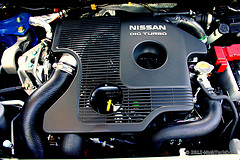There has never been a better time to buy a used vehicle than right now. It’s true! Previously owned vehicles last longer, are built better, and deliver more reliable service than ever in history. And many used vehicles can now be purchased with warranty and roadside assistance coverage, something that was unheard of in the day of buying a used vehicle “as is.” But, while used-vehicle bargains are out there in vast numbers, choosing just the right one for you is still fraught with several challenges. Making a bad buy can haunt you — and perhaps your credit — for years down the road. Before purchasing a used vehicle, it’s essential to find out as much as you can about the vehicle’s maintenance history and any mechanical problems it might be hiding.

flic.kr/p/cicoWy
“A rigorous test drive and a thorough inspection done by a certified automotive technician are the best ways to make sure the used vehicle you are considering buying is in good condition,” says Bob Arlotta, NAPA’s Technician of the Year.
According to him, inspections typically cost around $90, but if the technician discovers a major defect, you have saved yourself a giant headache and potentially thousands of dollars. When inspecting a used vehicle, experienced technicians normally check the following areas for existing problems and possible warning signs:
- Under the hood
The overall appearance of the vehicle’s engine compartment is important because any buildup of dirt or oil can indicate mechanical problems. Dirty and/or thick engine oil and noticeable sludge in the engine may indicate a lack of routine maintenance by the previous owners. Also, grey or milky engine oil may signify the presence of water, which can cause serious engine malfunctions. Any rattling noises heard while the engine is idling can mean incorrect tuning or excessive wear.
- Body
Floor wells, rocker panels, and doors should be checked for red stains and bubbled or dimpled paint, which can be signs of impending rust. The vehicle’s panel surfaces should also be inspected for hail damage and overall fit, since loose side panels may indicate past accident damage.
When inspecting the transmission of a used car, technicians test for smooth gear changes and listen for any rattles or knocking noises. On front-wheel drive vehicles, these noises can indicate worn constant-velocity joints. Radiator coolant should be clean and bright-colored. Oil in the coolant may indicate a cracked cylinder head or a leaking gasket. Radiator cooler fins and core tubes should also be checked for corrosion or damage. Additionally, check the vehicle’s battery for corrosion and remaining life.
- Road test
During a test drive, technicians are trained to look for excessive body lean or wandering on straight roads, which can be a sign of worn suspension or misaligned steering. A properly operating vehicle should stop smoothly and in a straight line. The pedal should not feel spongy or sink to the floor, and the steering wheel should not vibrate.
- Underneath the vehicle
Tires must be checked for uneven wear, which may indicate misaligned or worn steering or suspension. At the same time, the engine, transmission, axles, brakes, power steering and shock absorbers should be assessed for oil leaks. The exhaust system should be tested for fumes or excessive noise, which can indicate holes or rust in the pipes or muffler.
“Unless you have experience repairing vehicles, it’s probably a good idea to have the vehicle inspected by your regular automotive technician,” says Arlotta. “Spending a little bit of money to learn about a vehicle’s history and find out its current mechanical state will help you make an educated decision about your used-vehicle purchase.”
—Based in Cleveland, Ohio, Driving Today Contributing Editor Luigi Fraschini writes frequently on money-saving issues and vehicles. © Studio One Networks.
Tagged with: car records • test drive
Filed under: Buy A Car